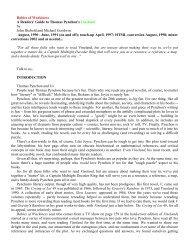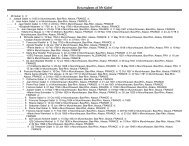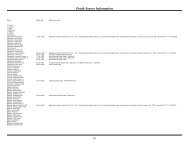CRC Handbook of Chemistry and Physics, 86th Edition
CRC Handbook of Chemistry and Physics, 86th Edition
CRC Handbook of Chemistry and Physics, 86th Edition
Create successful ePaper yourself
Turn your PDF publications into a flip-book with our unique Google optimized e-Paper software.
The Elements 4-15<br />
white, has a metallic luster, <strong>and</strong> is malleable <strong>and</strong> ductile. At<br />
room temperature, gadolinium crystallizes in the hexagonal,<br />
close-packed α form. Upon heating to 1235°C, α gadolinium<br />
transforms into the β form, which has a body-centered cubic<br />
structure. The metal is relatively stable in dry air, but in moist<br />
air it tarnishes with the formation <strong>of</strong> a loosely adhering oxide<br />
film which spalls <strong>of</strong>f <strong>and</strong> exposes more surface to oxidation.<br />
The metal reacts slowly with water <strong>and</strong> is soluble in dilute<br />
acid. Gadolinium has the highest thermal neutron capture<br />
cross-section <strong>of</strong> any known element (49,000 barns). Natural<br />
gadolinium is a mixture <strong>of</strong> seven isotopes. Two <strong>of</strong> these, 155 Gd<br />
<strong>and</strong> 157 Gd, have excellent capture characteristics, but they are<br />
present naturally in low concentrations. As a result, gadolinium<br />
has a very fast burnout rate <strong>and</strong> has limited use as a<br />
nuclear control rod material. It has been used in making gadolinium<br />
yttrium garnets, which have microwave applications.<br />
Compounds <strong>of</strong> gadolinium are used in making phosphors<br />
for color TV tubes. The metal has unusual superconductive<br />
properties. As little as 1% gadolinium has been found to improve<br />
the workability <strong>and</strong> resistance <strong>of</strong> iron, chromium, <strong>and</strong><br />
related alloys to high temperatures <strong>and</strong> oxidation. Gadolinium<br />
ethyl sulfate has extremely low noise characteristics <strong>and</strong> may<br />
find use in duplicating the performance <strong>of</strong> amplifiers, such as<br />
the maser. The metal is ferromagnetic. Gadolinium is unique<br />
for its high magnetic moment <strong>and</strong> for its special Curie temperature<br />
(above which ferromagnetism vanishes) lying just at<br />
room temperature. This suggests uses as a magnetic component<br />
that senses hot <strong>and</strong> cold. The price <strong>of</strong> the metal is about<br />
$5/g (99.9% purity).<br />
Gallium — (L. Gallia, France; also from Latin, gallus, a translation<br />
<strong>of</strong> Lecoq, a cock), Ga; at. wt. 69.723(1); at. no. 31; m.p. 29.76°C;<br />
b.p. 2204°C; sp. gr. 5.904 (29.6°C) solid; sp. gr. 6.095 (29.6°C)<br />
liquid; valence 2 or 3. Predicted <strong>and</strong> described by Mendeleev<br />
as ekaaluminum, <strong>and</strong> discovered spectroscopically by Lecoq<br />
de Boisbaudran in 1875, who in the same year obtained the<br />
free metal by electrolysis <strong>of</strong> a solution <strong>of</strong> the hydroxide in<br />
KOH. Gallium is <strong>of</strong>ten found as a trace element in diaspore,<br />
sphalerite, germanite, bauxite, <strong>and</strong> coal. Some flue dusts from<br />
burning coal have been shown to contain as much as 1.5%<br />
gallium. It is the only metal, except for mercury, cesium, <strong>and</strong><br />
rubidium, which can be liquid near room temperatures; this<br />
makes possible its use in high-temperature thermometers. It<br />
has one <strong>of</strong> the longest liquid ranges <strong>of</strong> any metal <strong>and</strong> has a low<br />
vapor pressure even at high temperatures. There is a strong<br />
tendency for gallium to supercool below its freezing point.<br />
Therefore, seeding may be necessary to initiate solidification.<br />
Ultra-pure gallium has a beautiful, silvery appearance, <strong>and</strong> the<br />
solid metal exhibits a conchoidal fracture similar to glass. The<br />
metal exp<strong>and</strong>s 3.1% on solidifying; therefore, it should not be<br />
stored in glass or metal containers, as they may break as the<br />
metal solidifies. Gallium wets glass or porcelain, <strong>and</strong> forms a<br />
brilliant mirror when it is painted on glass. It is widely used<br />
in doping semiconductors <strong>and</strong> producing solid-state devices<br />
such as transistors. High-purity gallium is attacked only slowly<br />
by mineral acids. Magnesium gallate containing divalent impurities<br />
such as Mn +2 is finding use in commercial ultraviolet<br />
activated powder phosphors. Gallium nitride has been used to<br />
produce blue light-emitting diodes. Blue LED’s used in compact<br />
disc applications can be used to store a 2-hr movie, for example,<br />
on one 5-in. diameter disc. Extensive use <strong>of</strong> gallium has<br />
found recent application in the Gallex Detector Experiment<br />
located in the Gran Sasso Underground Laboratory in Italy.<br />
This underground facility has been built by the Italian Istituto<br />
Nazionale di Fisica Nucleare in the middle <strong>of</strong> a highway tunnel<br />
through the Abruzzese mountains, about 150 km east <strong>of</strong><br />
Rome. The experiment is shielded by a 3300-m water-equivalent<br />
<strong>of</strong> rock. In this experiment, 30.3 tons <strong>of</strong> gallium in the<br />
form <strong>of</strong> 110 tons <strong>of</strong> GaCl 3 -HCl solution are being used to<br />
detect solar neutrinos. The production <strong>of</strong> 71 Ge from gallium<br />
is being measured.Gallium arsenide is capable <strong>of</strong> converting<br />
electricity directly into coherent light. Gallium readily alloys<br />
with most metals, <strong>and</strong> has been used as a component in lowmelting<br />
alloys. Its toxicity appears to be <strong>of</strong> a low order, but<br />
should be h<strong>and</strong>led with care until more data are forthcoming.<br />
Natural gallium contains two stable isotopes. Twenty-six other<br />
isotopes, one <strong>of</strong> which is an isomer, are known. The metal<br />
can be supplied in ultrapure form (99.99999+%). The cost is<br />
about $5/g (99.999%).<br />
Germanium — (L. Germania, Germany), Ge; at. wt. 72.61(2); at.<br />
no. 32; m.p. 938.25°C; b.p. 2833°C; sp. gr. 5.323 (25°C); valence<br />
2 <strong>and</strong> 4. Predicted by Mendeleev in 1871 as ekasilicon, <strong>and</strong> discovered<br />
by Winkler in 1886. The metal is found in argyrodite, a<br />
sulfide <strong>of</strong> germanium <strong>and</strong> silver; in germanite, which contains<br />
8% <strong>of</strong> the element; in zinc ores; in coal; <strong>and</strong> in other minerals.<br />
The element is frequently obtained commercially from flue<br />
dusts <strong>of</strong> smelters processing zinc ores, <strong>and</strong> has been recovered<br />
from the by-products <strong>of</strong> combustion <strong>of</strong> certain coals. Its<br />
presence in coal insures a large reserve <strong>of</strong> the element in the<br />
years to come. Germanium can be separated from other metals<br />
by fractional distillation <strong>of</strong> its volatile tetrachloride. The<br />
tetrachloride may then be hydrolyzed to give GeO 2 ; the dioxide<br />
can be reduced with hydrogen to give the metal. Recently<br />
developed zone-refining techniques permit the production <strong>of</strong><br />
germanium <strong>of</strong> ultra-high purity. The element is a gray-white<br />
metalloid, <strong>and</strong> in its pure state is crystalline <strong>and</strong> brittle, retaining<br />
its luster in air at room temperature. It is a very important<br />
semiconductor material. Zone-refining techniques have led to<br />
production <strong>of</strong> crystalline germanium for semiconductor use<br />
with an impurity <strong>of</strong> only one part in 10 10 . Doped with arsenic,<br />
gallium, or other elements, it is used as a transistor element in<br />
thous<strong>and</strong>s <strong>of</strong> electronic applications. Its application in fiber<br />
optics <strong>and</strong> infra-red optical systems now provides the largest<br />
use for germanium. Germanium is also finding many other<br />
applications including use as an alloying agent, as a phosphor<br />
in fluorescent lamps, <strong>and</strong> as a catalyst. Germanium <strong>and</strong> germanium<br />
oxide are transparent to the infrared <strong>and</strong> are used<br />
in infrared spectroscopes <strong>and</strong> other optical equipment, including<br />
extremely sensitive infrared detectors. Germanium<br />
oxide’s high index <strong>of</strong> refraction <strong>and</strong> dispersion has made it<br />
useful as a component <strong>of</strong> glasses used in wide-angle camera<br />
lenses <strong>and</strong> microscope objectives. The field <strong>of</strong> organogermanium<br />
chemistry is becoming increasingly important. Certain<br />
germanium compounds have a low mammalian toxicity, but a<br />
marked activity against certain bacteria, which makes them <strong>of</strong><br />
interest as chemotherapeutic agents. The cost <strong>of</strong> germanium<br />
is about $10/g (99.999% purity). Thirty isotopes <strong>and</strong> isomers<br />
are known, five <strong>of</strong> which occur naturally.<br />
Gold — (Sanskrit Jval; Anglo-Saxon gold), Au (L. aurum, gold);<br />
at. wt. 196.96654(3); at. no. 79; m.p. 1064.18°C; b.p. 2856°C;<br />
sp. gr. ~19.3 (20°C); valence 1 or 3. Known <strong>and</strong> highly valued<br />
from earliest times, gold is found in nature as the free metal<br />
<strong>and</strong> in tellurides; it is very widely distributed <strong>and</strong> is almost<br />
always associated with quartz or pyrite. It occurs in veins <strong>and</strong><br />
alluvial deposits, <strong>and</strong> is <strong>of</strong>ten separated from rocks <strong>and</strong> other<br />
minerals by sluicing <strong>and</strong> panning operations. About 25% <strong>of</strong>







